A Palermo Food Tour Review
Pizza and pasta are often the first things that people associate with Italy, but did you know that the island of Sicily has its very own gastronomy which is worlds apart from the mainland?
Palermo in particular has its own distinct street food scene, and so when tour company Streaty invited me on a Palermo food tour, I jumped at the chance to learn more about Palermo’s culinary traditions.
Streaty, the self-professed ‘pioneers of street food tours in Italy,’ run tours in Catania, Taormina, Naples, and other Italian cities, but they are actually based in Palermo, which is said to be one of the best cities for street food in the entire world!
So, if you’re planning a trip to Palermo and are wondering whether it’s worth going on a Palermo food tour, this post will tell you all you need to know about what foods you’ll try, where you’ll go, and most importantly, whether Palermo street food tours are really worth the money.
Are you ready?
Then let’s get into it.
Savouring Sicily: A Palermo Food Tour Experience
What is Palermo food like?
While it certainly has a lot in common with Italian food, Sicilian food is an amalgamation of all of the cultures that have existed on the island of Sicily over the years.
These include the Arabs, Romans, Normans, Greeks, Spanish, Jews, and so on.
From the Arab domination of Sicily in the 10th and 11th centuries, we see saffron, apricot, raisins, rice, nutmeg, cloves and pine nuts, with the Greeks bringing a taste for fish, pistachio, olives and fresh vegetables.
In Western Sicily, you will find Northern African influences – San Vito Lo Capo even has its very own couscous festival!
In Palermo, street food is an integral part of the city’s culture.
Dishes are often prepared fresh and served piping hot from street vendors, small eateries, and food markets.
You can expect intense flavours and rich textures, and a whole lot of offal – seriously, Palermitani love their offal!
Common local ingredients include eggplant, swordfish, and sardines.
Just like the street food itself, a Palermo food tour is not just about the food, but also about the experience of exploring the city’s vibrant streets, meeting the locals, and immersing yourself in Palermo’s lively culture.
My street food tour, Palermo
I met Marco Romeo, owner of Streaty and born and bred Palermitano, outside the magnificent Teatro Massimo on Piazza Giuseppe Verdi (which is incidentally one of the best things to see in Palermo).
I was a little nervous about attending the tour alone, but Marco was so personable and chatty from the get go that the ice was broken between everyone in the group right away, and I found myself immediately at ease.
Our group was small but eclectic – together we were English, French, American, Ukrainian, and Polish – and we had a great group dynamic from the very beginning, thanks to Marco.
As he gave us a bit of background about himself and his company, Marco explained that one of his Palermo food tours is less of an organised tour and more of a meeting with friends.
‘To me, you are friends visiting Sicily, and just as I would with any friends, I’m going to take you to the places that I, as a Sicilian, go. It doesn’t matter how dirty the place is, or how challenging the food may be – this is where we go to eat, so this is where we take you.’
Already I liked him, and I knew that this tour would be an authentic introduction to Palermo street food.
Our first port of call on our Palermo street food tour was the bustling Mercato del Capo, or the Capo Market, just a few minutes’ walk away from Teatro Massimo.
Mercato del Capo
Mercato del Capo is one of Palermo’s 4 historic street markets.
It was founded by Arabs and has been open every single day for over 1000 years, with the exception of the Patron Saints day of St. Rosalia.
Just outside Porta Carini, one of the oldest city gates, stands Toni, a serious looking man standing in front of a wicker basket (known as a panaru) covered with a blanket that makes it impossible to see what’s hiding inside.
Having spent a lot of time in Palermo, I knew exactly what was about to come, and I wondered how the other guests of the tour would feel about what they were about to eat.
Marco grinned and looked right at me.
‘Do you know what this is, Dani?’
I nodded. ‘I do indeed.’
I had actually been asking around my Palermitani friends if they knew where I could get my hands on some frittula, but had always been met with wrinkled noses and disgusted expressions, and the question ‘why would you want to eat that?!’
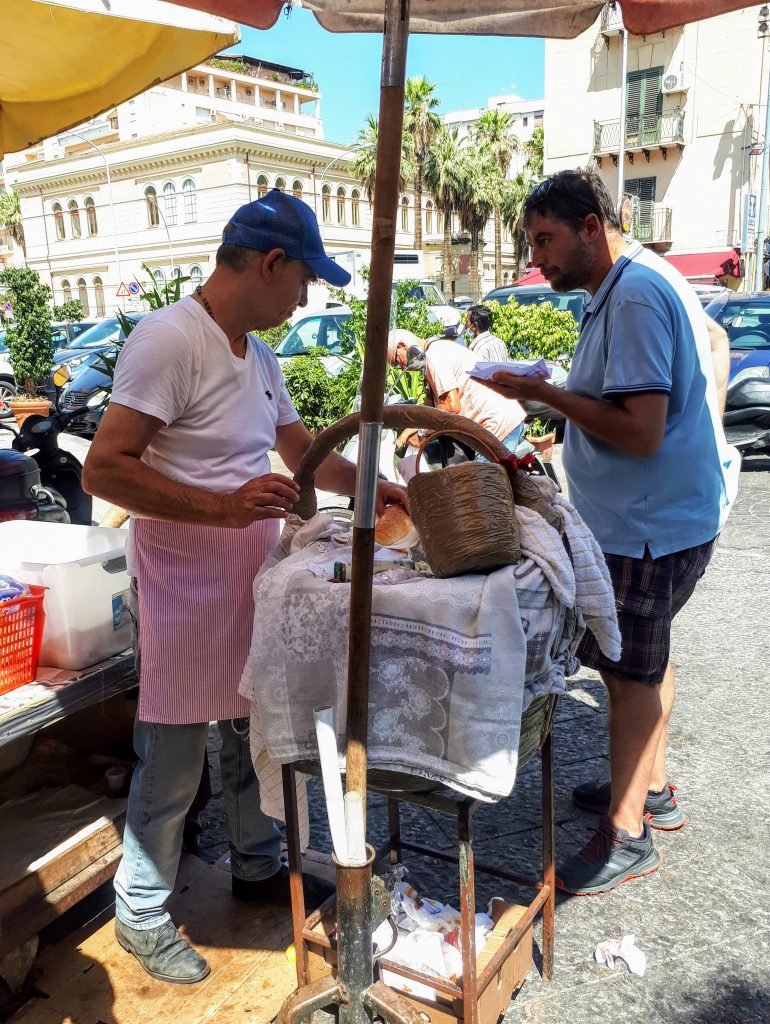
Frittula
But what exactly is frittula?
Not for the faint-hearted, frittula dates back to the 15th century and is probably the most mysterious Palermo street food out there.
The defining characteristic of frittula is that it is always hidden underneath a cloth that is never lifted, not even for a moment.
If you are brave enough to order a portion, Toni will reach underneath the cloth with his bare hand and grab a handful of ‘stuff’ from inside, slapping it onto some grease paper or a sesame bun, along with a squirt of lemon and a liberal amount of black pepper.
The taste can be compared to crispy chicken skin or salty pork crackling.
In fact, what you are consuming is the slaughterhouse waste of a calf’s carcass, including ground bone, cartilage and scraps of meat not fit to be sold.
All of this is boiled and fried in lard, before being seasoned with bay leaves, lemon and pepper, and served to peckish Sicilians for around a euro a portion.
As we finished licking the grease off our fingers, Marco gestured for us to follow him into the cobbled streets of Capo Market, where we’d find our next bite to eat.

Walking through Capo Market is as good an introduction to Palermo as you can get (with the possible exception of Ballaro market), and your every sense will be aggressively stimulated.
If you’ve ever been to Marrakech, you’ll have an idea of what I’m talking about.
Children as young as 10 zip by on mopeds, stray dogs meander lazily by, and the smells of fresh fish, greasy fried goodness, and exotic vegetables are only punctuated by the sounds of the vendors yelling and singing, an Arab tradition that has survived the last 10 centuries.
Marco told us that Mercato del Capo is like an open air supermarket, only with cheaper and better ingredients and chattier sellers.
I think that this massively downplays the Palermo market experience, where 3 foot long courgettes sit alongside countless different types of tomato, and the bread made using a secret recipe and cooked in a wood oven in Monreale, a hilltop village above Palermo.
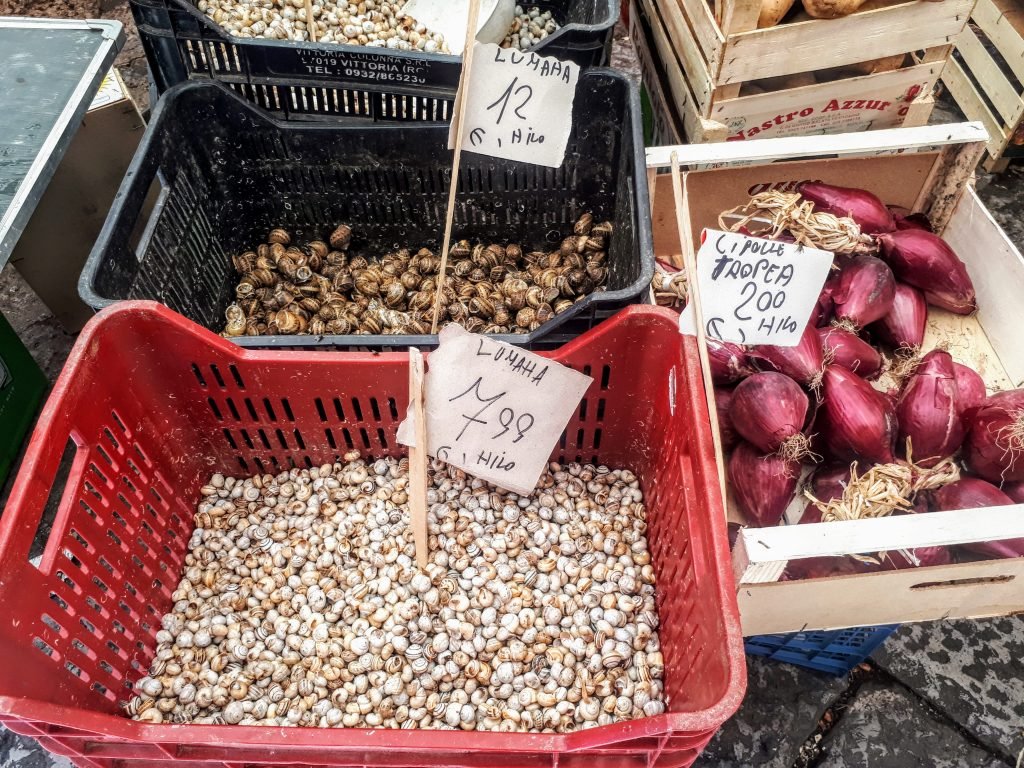
We passed by a fishmonger’s and Marco beckoned us over to a shady spot by the side of the stall to explain the art of food shopping in the Palermo markets to us.
‘First of all, if you don’t like to talk then you should do your shopping at the supermarket,’ Marco laughed.
‘The sellers here will want to know everything about you, including what you intend to do with their products. If you are choosing the wrong type of tomato for the pasta you want to make, they will refuse to sell it to you, giving you the right one instead. You must tell them how you plan to cook the food so that they can help you choose accordingly – if you’re hosting a BBQ then they will give you the juiciest fish, while if you want to make pasta with the fish, they will cut it into cubes for you.’
Most importantly, he told us, it is imperative to have a good relationship with your fishmonger.
If you are new to town, you should find a local to introduce you so that you won’t be given a bad fish.
If you build a relationship with your fishmonger and he sees you buying fish elsewhere, your relationship probably won’t recover.
The politics of this may sound complicated, but that is precisely what the Palermitani love about the market.
The gossip and drama, the challenge of winning over a local seller and being given the best goods, and the thrill of realising you’ve been overcharged and confronting the vendor next time you pass by (he will reward your boldness with a discount or a freebie) is what makes shopping in the Palermo markets so special.
The stall that we are standing beside is a family affair.
Three brothers stand front of house, displaying their decapitated swordfish and tuna steaks proudly, while their wives remain tucked away behind the scenes, using the morning’s catch to prepare swordfish caponata, octopus salad, and pasta con le sarde for the construction workers and lawyers alike to gobble up on their lunch breaks.
And when is the best time to visit Palermo’s markets?
‘Early in the morning or just before they close,’ Marco told us. ‘Of course, if you go early, you will find the best fish, but at the end of the day, they are trying to get rid of things and you will always get something extra thrown in for free.’
After Marco finished explaining how to buy food at Capo Market, it was time for some more food, and it wouldn’t be a Palermo food tour without an arancina or six!
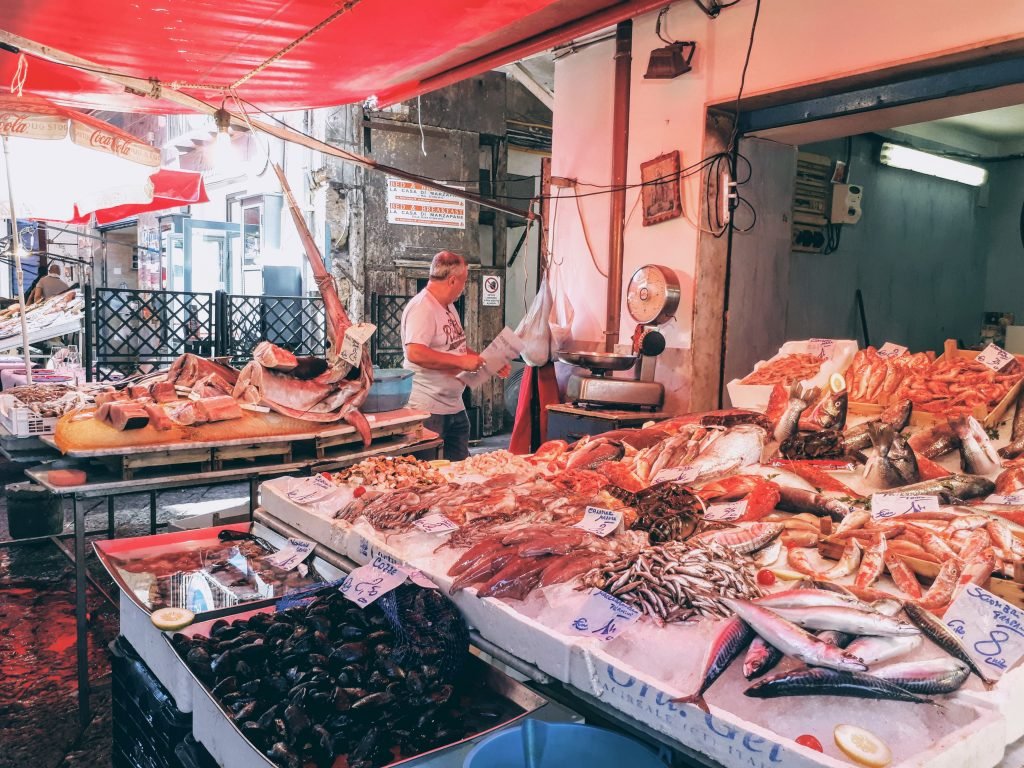
Arancine – The quintessential Sicilian street food
Arancine are the most quintessential Sicilian street food there is, and it isn’t difficult to see why.
Certainly easier to stomach for the general public than frittula, arancine take their name from arancia, Italian for ‘oranges,’ because, well, they look like oranges!
Arancine are balls of creamy yellow risotto (the rice takes its colour from the saffron brought over by the Arabs), deep fried in breadcrumbs and filled with just about anything!
Usually though, arancine will be stuffed with a ragu meat sauce or ham and mozzarella.
Marco took us to an unremarkable little café with red plastic chairs outside and a dingy feel.
It’s the kind of place that you would walk past without a second glance, but, as with most things in Palermo, sometimes the best things are found in the unlikeliest of places.
Marco explained that for the most part, ragu arancine in Palermo are no longer prepared in the traditional way, and that Piera, the lady who runs the show, is the only person who still makes arancine using the original recipe, which is over 1000 years old.
These arancine do not have tomato sauce inside them, only minced veal, peas, onions and carrots, and they are served at room temperature to make the rice stick together and prevent it from falling apart when bitten into!
Fun fact – in Catania this Sicilian street food is known as ‘arancino’ and ‘arancini’ and the two cities will fight to the death about which is the correct version!
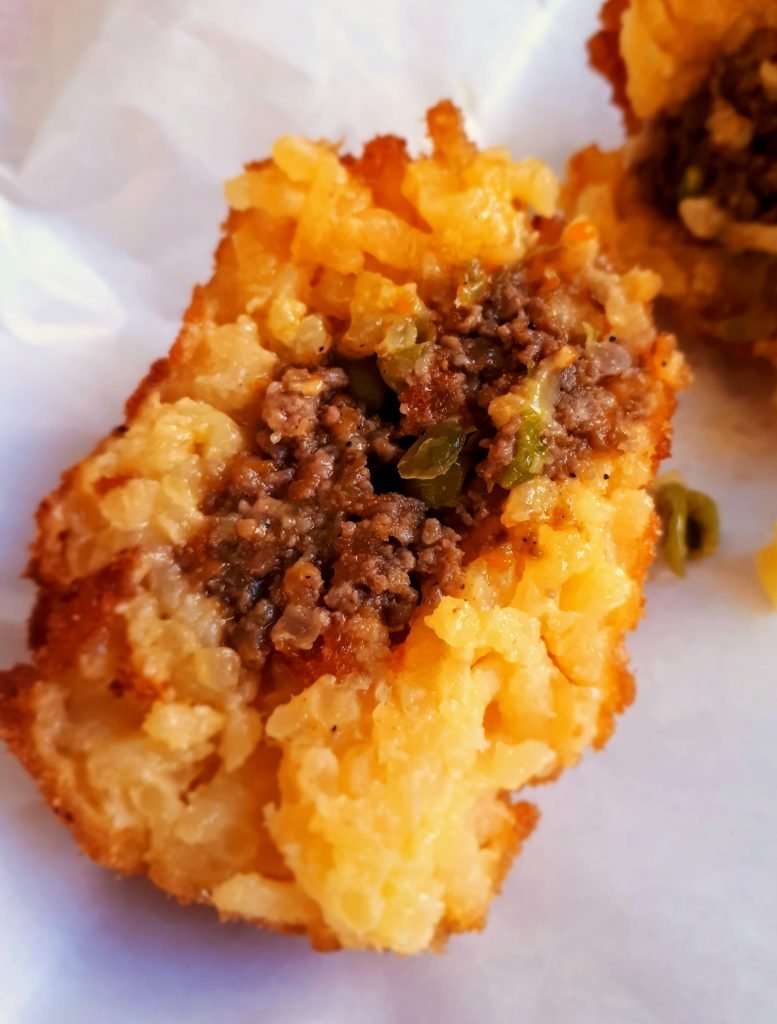
Cazzilli and Panelle
Before we’d even finished the arancine, more goodies appeared on paper plates in front of us – cazzilli (or crocchè di patate to give them their proper name), and panelle.
Cazzilli, which literally translates to ‘little dicks’ (!), are little potato croquettes made from mashed potato that has been covered with breadcrumbs, deep fried and seasoned with mint and parsley.
Panelle, which are never usually far away from cazzilli, are flat chickpea fritters made from chickpea flour, water, salt and parsley.
They can be eaten alone or on a sandwich, sometimes with the cazzilli as well – a Palermitani chip butty, if you will (who would have thought that street food in Sicily would have anything in common with my Manchester roots?!).

After we’d finished, Marco took us down a narrow alleyway behind the cafe.
‘Here you can see the panelle being made,’ he said, gesturing into the doorway of a room where two men quickly and methodically pressed and rolled the raw mixture.
It was mesmerising to watch them work, never missing a beat despite the high speed at which they were working.
It seems that practice really does make perfect.
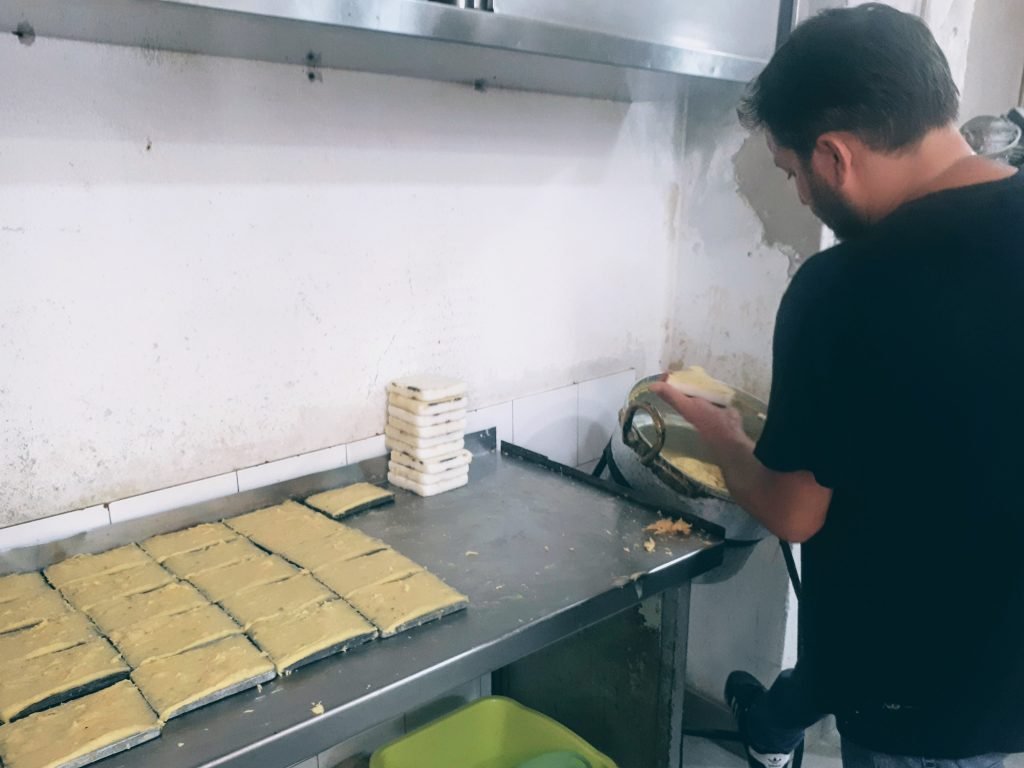
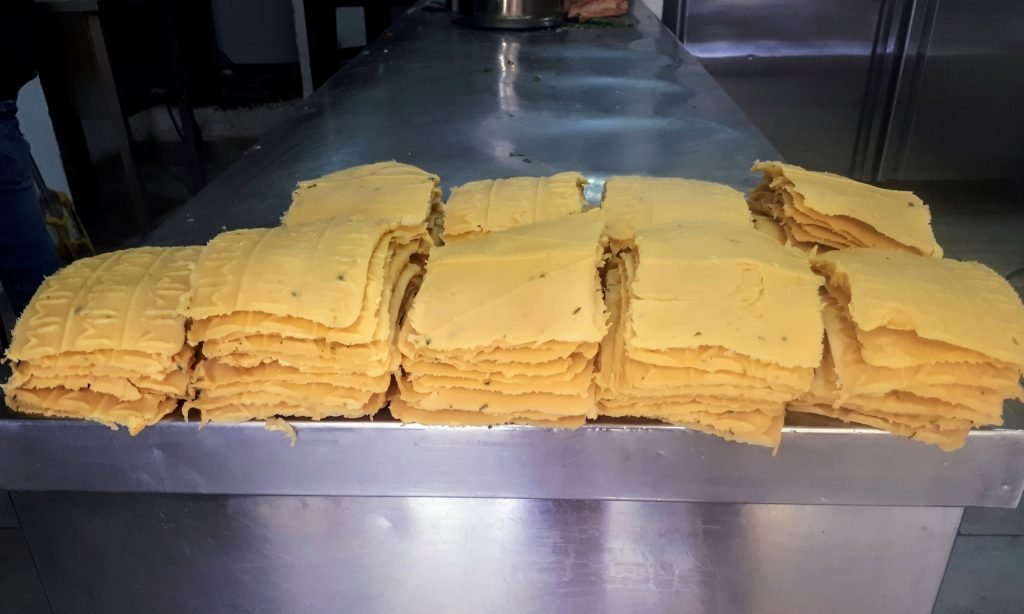
Cheese, glorious cheese…
After we’d gawked at the men for long enough, we left them to it and walked further into the market, stopping at a hole in the wall shop named Buone Feste (‘Happy Holidays!’) that specialises in baked ricotta and other typical Sicilian cheeses.
Cheese in Sicily is mainly cow and sheep cheese, the latter of which explains the inclusion of ricotta in everything – there are simply too many sheep in Sicily!
Marco wanted us try some fresh cow cheese as he said the hot weather wouldn’t suit the saltier, richer cheeses, but the man in the shop insisted that we try some of his aged pecorino as well because, he told us, it was just too good to miss!
Although the pecorino was nice, the fresh cow cheese, which was a lot smoother and milder in flavour, was easier to eat in the 35 degree heat!
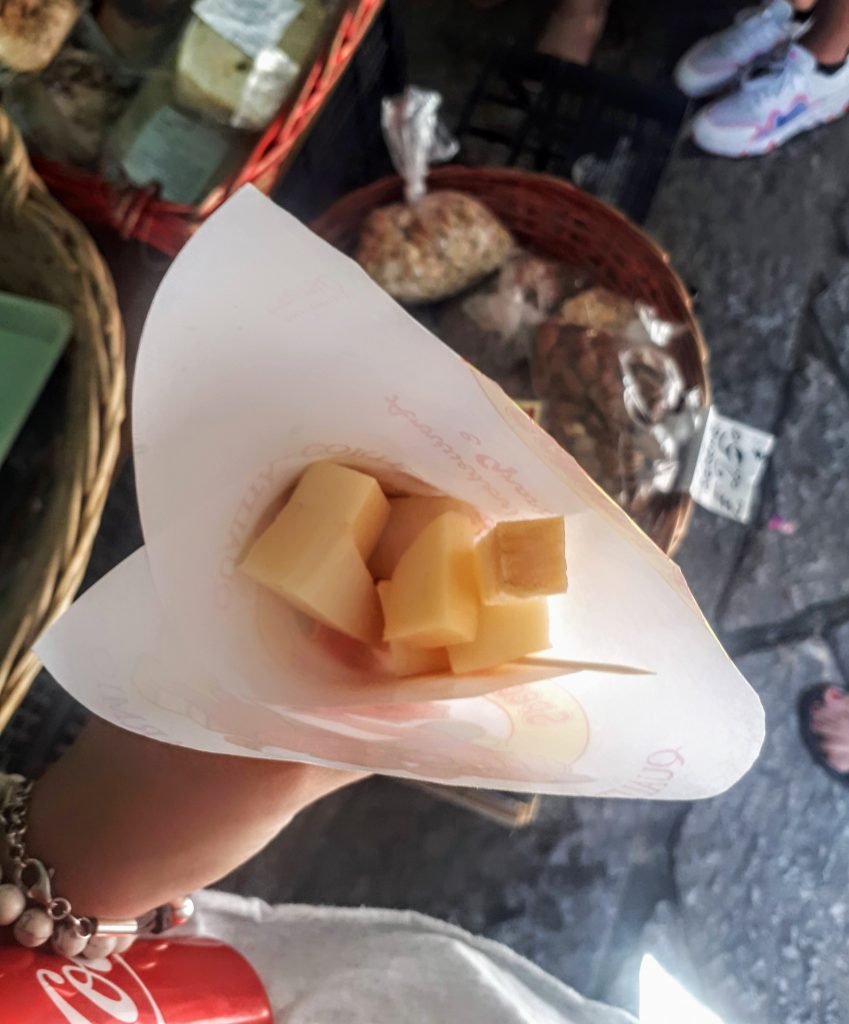
La Vucciria
By this point, we were just about done with Capo Market and it was time to explore another of Palermo’s legendary markets – La Vucciria.
The first food that we tried here was a Palermo classic – sfincione.
Sfincione is a kind of pizza bread (not a comparison many Sicilians like!).
It was originally a kind of ‘peasant food’ that was born from the need to dry, long-lasting products that would nourish those working in fields far from home.

It begins with a doughy bread base that is then topped with various ingredients.
The classic Palermo sfincione is made with tomato puree and seasoned with salt, pepper and extra virgin olive oil, but the sfincione that we tried on our Palermo food tour was the Bagherese version.
This type of sfincione skips the tomato puree altogether and uses olive oil, anchovies, fresh pecorino, breadcrumbs, oregano, and scallion onions.
This was my first time ever trying Bagherese sfincione, and I have to say that I actually preferred it to the Palermitani version!
The salty cheese, onions and fresh herbs create a wonderfully strong flavour, while the breadcrumbs give it a crunch that its Palermitan relative lacks.
Blood wine
Before we’d even had a chance to dust the crumbs off our fingers, Marco led us to a legendary Vucciria dive bar – Taverna Azzura.
Taverna Azzura is an old man’s pub by day and beloved student haunt by night, with an interior that hasn’t changed at all over the years and a crowd of locals that frequent the place so often that they may as well be part of the furniture.
Marco explained that when he was younger, he would sit inside Taverna Azzura and gaze out at curious tourists, all of whom were peering in inquisitively, but none of whom were brave enough to actually go inside and order a drink.
With Streaty, he wants to bridge the gap between tourists and locals, helping cautious travellers overcome their fears and dive into the unknown.
Taverna Azzura, he said, is a must-visit, and as somebody who has taken many a 1 EUR shot at the sticky bar, I can confirm that this is true.
The reason for our visit to Taverna was to try Sangue, a fortified wine whose name literally translates to ‘blood.’
Sangue is a kind of dessert wine with a pungent smell similar to Sherry, served to us from repurposed water coolers in white plastic cups.
As soon as the sickly sweet liquid touched my lips, I knew that I’d been given this before, on one of many drunken nights out on La Vucciria.
‘I – probably wouldn’t buy this again,’ I grimaced, taking another couple of sips before laying my cup down on the bar.
Usually, I’d drink 1 EUR wine no matter the taste, but when you can get an ice cold bottle of beer for the same price, it’s no competition – sorry, not sorry.
Pani ca’ Meusa
As we made our way onto the main piazza, I spotted Rocky Basile, one of the most well-known Palermo street food vendors who has been serving up his speciality since he was six years old, and his father and grandfather before him.
And what is this speciality, you ask?
Pani ca’ Meusa is a sandwich not for the faint-hearted or those with a delicate stomach.
Made with chopped veal lung, spleen, and trachea that have been boiled and fried with lard, Pani ca’ Meusa was brought to Palermo by the Jews in the 13th century and is about as authentic as you can get when it comes to street food in Palermo.
The mixture is left to bubble away in a large pot before being slapped onto a sesame seeded bun, squirted with a dash of lemon juice, and a generous helping of salted ricotta cheese.
Pani ca’ Meusa has quite a strong flavour – to me, it tastes a bit like kidneys, if kidneys were piping hot, drenched in lemon juice and sitting on a fluffy bun.
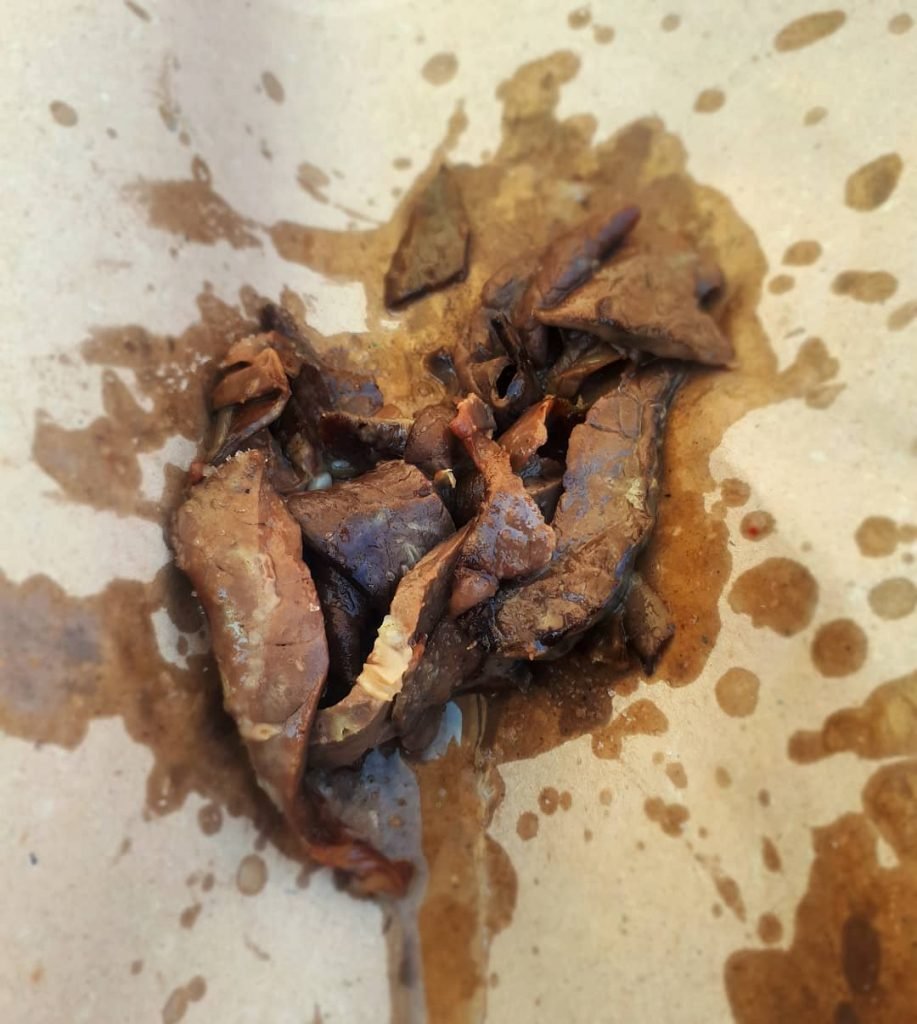
My shorts were really starting to feel tight at this point, and I have to admit that I breathed a sigh of relief when Marco told us that the next stop would be our last – I don’t think I could have managed anymore!
We wandered down a narrow cobbled street down towards the port and into a gelateria, tucked away from the main tourist strip of Via Vittorio Emanuele.
Marco told us that we could choose two scoops each, in either a tub, a cone or a brioche bun (the Palermo way of doing things).
As I was absolutely stuffed by this point, I opted for the cup, choosing a refreshing lemon sorbet, paired with a peachy pink mix of mandarin, orange and melon.
As we savoured the last flavours of our tour, Marco wrapped things up – part of me couldn’t believe that we’d all been together for 3 hours but my bulging stomach certainly said otherwise!

How much does a Palermo street food tour cost?
The tour that I took costs 51.90 EUR.
This includes a 3 hour guided tour by Marco or another local guide, plus everything we ate and drank.
As a reminder, this included frittula, panelle, cazzilli, pani ca’ meusa, sangue wine, arancine, a cheese cone, sfincione, gelato, and a bottle of beer (or soft drink).
Personally, I think that for a small group tour, this price is more than fair.
Marco’s expert and colourful commentary outlined Palermo’s food culture in a way that I simply can’t do justice to in this post, and while I thought that I knew Palermo inside out before I went on this tour, Marco managed to make me fall even deeper in love with this city.
Palermo Food Tour | Final Thoughts
Palermo street food is not easy.
It does not try to accommodate squeamish foreigners by diluting its flavour or switching up its ingredients.
If you like it, great, and if you don’t then you’re very much welcome to trot off on the horse you rode in on.
Marco’s Palermo food tour epitomises all of this.
It doesn’t matter to Marco how challenging the food may be or how dirty the establishment is – Marco eats there, so that’s where he’s taking you to eat.
For me, this is what makes a Streaty tour the way to discover Palermo’s gastronomy.
Fancy restaurants are all well and good, but Palermo is gritty and unapologetic, so why should your introduction to it be anything else?
Not only is Streaty’s Palermo food tour authentic, but it’s also socially responsible – by participating, you’re helping out small family businesses that wouldn’t ordinarily make much money from tourists.
Thank you to Marco and Streaty for inviting me on this tour and giving me such a wonderful day!
More Palermo Guides
Things to Do in Palermo
Best Cafes in Palermo
Best Aperitivo in Palermo
Best Restaurants in Palermo
Palermo’s Historic Markets
Guide to La Vucciria Market, Palermo
Palermo’s Street Food
Day Trips from Palermo
San Vito Lo Capo
Cefalu
Trapani
Favignana
Erice
Western Sicily Bucket List
General Sicily Guides
Solo Travel in Sicily
Safety in Sicily
Traditional Sicilian Food
If you liked this article and would like to support my work, please click the button above to donate a couple of bucks and buy me a coffee. The ad revenue that I receive on this website is minimal, so support from my readers enables me to keep creating content that you (hopefully!) love to read.

Disclaimer: I attended this tour as a guest of Streaty. This page also contains affiliate links.

My biggest fear with markets like those is that I can’t predict what it will cost if I shop there when there are no prices on things and I don’t speak the language.
Because of that, I only buy something there occasionally and if I don’t need to be too careful with my money that day.
The Lidl is certainly less complicated.
I agree, I like to be able to see the prices for sure, not because I think I’m being scammed but because I don’t want to go over budget accidentally! I love a good Lidl trip, haha.